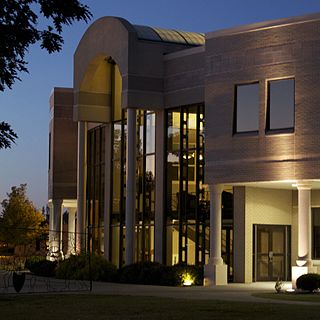
David Hilbert was a German mathematician and one of the most influential mathematicians of the 19th and early 20th centuries. Hilbert discovered and developed a broad range of fundamental ideas in many areas, including invariant theory, the calculus of variations, commutative algebra, algebraic number theory, the foundations of geometry, spectral theory of operators and its application to integral equations, mathematical physics, and the foundations of mathematics.
David Hilbert (1862–1943) was a German mathematician.

West Virginia is a state in the Southern United States. It is bordered by Pennsylvania to the north and east, Maryland to the east and northeast, Virginia to the southeast, Kentucky to the southwest, and Ohio to the northwest. West Virginia is the 10th-smallest state by area and ranks as the 12th-least populous state, with a population of 1,793,716 residents. The capital and largest city is Charleston which has a population of 49,055.

Wilhelm Friedrich Ackermann was a German mathematician and logician best known for his work in mathematical logic and the Ackermann function, an important example in the theory of computation.

Wirt County is a county in the U.S. state of West Virginia. As of the 2020 census, the population was 5,194, making it the least populous county in West Virginia. Its county seat is Elizabeth. The county was created in 1848 by the Virginia General Assembly and named for U.S. Attorney General and presidential candidate William Wirt. The county is served by one high school, Wirt County High School.

Hilbert's problems are 23 problems in mathematics published by German mathematician David Hilbert in 1900. They were all unsolved at the time, and several proved to be very influential for 20th-century mathematics. Hilbert presented ten of the problems at the Paris conference of the International Congress of Mathematicians, speaking on August 8 at the Sorbonne. The complete list of 23 problems was published later, in English translation in 1902 by Mary Frances Winston Newson in the Bulletin of the American Mathematical Society.
In functional analysis, a unitary operator is a surjective bounded operator on a Hilbert space that preserves the inner product. Unitary operators are usually taken as operating on a Hilbert space, but the same notion serves to define the concept of isomorphism between Hilbert spaces.

Hilbert College is a private Franciscan college in Hamburg, New York. The college is named after Mother Colette Hilbert of the Franciscan Sisters of Saint Joseph, who founded the school in 1957 to train teachers. Hilbert College enrolls approximately 800 students and grants both undergraduate and master's degrees.
Hilbert's axioms are a set of 20 assumptions proposed by David Hilbert in 1899 in his book Grundlagen der Geometrie as the foundation for a modern treatment of Euclidean geometry. Other well-known modern axiomatizations of Euclidean geometry are those of Alfred Tarski and of George Birkhoff.

Martin David Davis was an American mathematician and computer scientist who made significant contributions to the fields of computability theory and mathematical logic. He is best known for his work on Hilbert's tenth problem leading to the MRDP theorem. He also advanced the Post-Turing Model and co-developed the Davis–Putnam–Logemann–Loveland (DPLL) algorithm which is foundational for Boolean satisfiability solvers.
In mathematics, a Hilbert–Schmidt operator, named after David Hilbert and Erhard Schmidt, is a bounded operator that acts on a Hilbert space and has finite Hilbert–Schmidt norm

The Hilbert curve is a continuous fractal space-filling curve first described by the German mathematician David Hilbert in 1891, as a variant of the space-filling Peano curves discovered by Giuseppe Peano in 1890.

Andrew John Hilbert is an American former professional ice hockey forward who played in the National Hockey League with the Boston Bruins, Chicago Blackhawks, Pittsburgh Penguins, New York Islanders and the Minnesota Wild.

Roberto Jan Hilbert is a German former professional footballer. At international level, he earned eight caps with the Germany national team and twelve caps with the U21 team.
Vi Hilbert was a Native American tribal elder of the Upper Skagit, a tribe of the greater Coast Salish in Washington state, whose ancestors occupied the banks along the Skagit River, and was a conservationist of the Lushootseed culture and its language, of which she was the last fully fluent heritage speaker. She taught Lushootseed at the University of Washington for 17 years (1971–1988), where she also transcribed and translated Lushootseed recordings from the 1950s. This work is preserved in the university's audio library.
In number theory, a branch of mathematics, a Hilbert number is a positive integer of the form 4n + 1. The Hilbert numbers were named after David Hilbert. The sequence of Hilbert numbers begins 1, 5, 9, 13, 17, ... )

Hilbert Wildlife Management Area is located in Lincoln County near Sod, West Virginia, less than forty-five minutes drive south of Charleston, the state capital. Located on 289 acres (117 ha), the WMA land is steep and heavily covered with second growth hickory-oak hardwood forest.

In mathematics, Hilbert spaces allow the methods of linear algebra and calculus to be generalized from (finite-dimensional) Euclidean vector spaces to spaces that may be infinite-dimensional. Hilbert spaces arise naturally and frequently in mathematics and physics, typically as function spaces. Formally, a Hilbert space is a vector space equipped with an inner product that defines a distance function for which the space is a complete metric space.

The Hilbert Circle Theatre, originally called the Circle Theatre, is in Indianapolis, Indiana, on Monument Circle in the Washington Street-Monument Circle Historic District. It was originally built in 1916 as a "deluxe movie palace" and now is the home of the Indianapolis Symphony Orchestra.

Harvey Daiho Hilbert Roshi is a psychotherapist and an expert on post-Vietnam stress syndrome. He is an ordained Soto Zen priest and the founding abbot of the Order of Clear Mind Zen and a leader of the Zen community in southern New Mexico. He was featured in a documentary on Vietnam Veterans that aired on both National Public Radio's "Morning Edition" and PBS station KRWG-TV. During combat in the Vietnam War Hilbert was shot in the head, leaving him paralyzed on the left side of his body. Despite his injuries, Hilbert went on to college.















